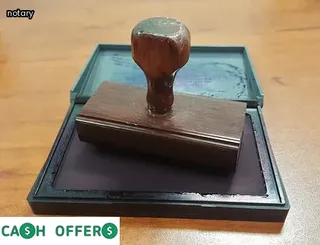Using a Minnesota Quitclaim Deed Form for house transfers provides many benefits. It is a simple and efficient way to transfer property rights from one person to another, with minimal effort.
This form allows you to quickly and easily change the ownership of a property, without any additional paperwork or legal fees. Furthermore, it offers the assurance that the deed is legally binding, since it is filed with the county recorder's office.
The quitclaim deed also offers more flexibility than other types of deeds because it does not require an appraisal or survey of the property before transferring ownership. Additionally, you can use this form even if you are uncertain about who currently owns the property.
Finally, using this form ensures that all parties involved in the transaction have been provided with full disclosure regarding the terms of the transfer and they have agreed to them in writing.

Completing a Minnesota Quit Claim Deed for house transfers is an easy process, but there are certain requirements that must be met in order to make it valid. The deed must include the names of both the grantor and grantee, as well as their addresses, and must be signed by both parties.
Notarization is also necessary, with the notary public's signature and seal affixed to the document. Additionally, each party involved must provide their driver's license or state ID number on the form.
It is also important to note that in Minnesota, all deeds must contain a legal description of the property being transferred. This should include a street address if available, or an accurate description of the land according to its township and range number.
All other relevant information such as consideration amount paid or received should also be included in the deed. Finally, once completed it is advised that a copy of this document be provided to both parties for their records.
If an error is made on a Minnesota Quitclaim Deed Form, the consequences can be serious. The document itself is legally binding, so any mistakes may jeopardize the entire transfer of the property.
Errors such as incorrect signatures, missing details, or incorrect names can all render the deed invalid and cause delays in transferring title of the property. When filling out a Minnesota Quitclaim Deed Form, it is important to double-check that all information is correct and that all required fields are filled out fully before submitting.
If errors are found after submitting the form, it is best to contact an attorney or a notary public right away to help correct any errors and avoid potential legal issues.

In order to obtain a Minnesota Quitclaim Deed Form, individuals must contact the Minnesota Department of Revenue or access their website. The form is available in both paper and electronic format.
To acquire the document in paper form, it can be requested by mail or picked up in person at any Revenue office. An individual obtaining the form should also ensure they have all of the necessary information to complete the deed, including legal description of the property, names and addresses of all parties involved in the transfer, signature dates and notarization.
It is important to note that before completing this form, any applicable taxes or fees must be paid. Additionally, when acquiring a Minnesota Quitclaim Deed Form online from the Department of Revenue website, an individual will need to provide proof of identity and their Social Security number for verification purposes.
In Minnesota, the two most common types of deeds used to transfer ownership of a house are warranty and quitclaim deeds. A warranty deed is the most popular choice as it not only conveys ownership but also includes guarantees from the seller that there are no other claims against the property.
This means that if someone does make a claim against the property in the future, the seller will be held responsible and must compensate for any financial losses incurred. A quitclaim deed, on the other hand, only conveys ownership without any warranties or guarantees from the seller.
This means that if someone does make a claim against the property in the future, it is up to them to prove their claim and they have no legal recourse against the original seller. Additionally, when completing a Minnesota Quit Claim Deed, all parties involved must sign off on all documents and have them witnessed by a notary public before they can be finalized.
The deed should also include information such as an accurate description of the property being transferred and its location as well as details about each party involved in order to ensure proper filing with local authorities.

Using a Minnesota Quitclaim Deed has its advantages and disadvantages when it comes to transferring ownership of a house. As one of the simplest and most affordable methods of transferring property, the quitclaim deed does not provide any guarantee that the person signing over the deed actually owns the property, nor does it confirm that title is free from any claims.
This means that on completion of a Minnesota Quitclaim Deed, there is no assurance that any claims existing against the property can be satisfied by the party receiving the deed. However, this type of transfer can be an effective method for ensuring quick transfers between family members or close friends who are confident in each other's rights to ownership.
Moreover, since there is no requirement for a title search or title insurance prior to completion, this type of transfer can usually be completed much faster than other types of conveyance. In addition, unlike a warranty deed which requires more detailed paperwork and processing time, a Minnesota Quitclaim Deed typically only requires a few pieces of basic information such as names and addresses to complete.
Ultimately, whether or not using this form of conveyance for house transfers is right for you will depend on your specific situation and needs.
Transferring property in Minnesota is a straightforward process when using a quitclaim deed. A quitclaim deed transfers the interest of the grantor, or seller, to the grantee, or buyer.
The Minnesota quit claim deed must include specific information and follow legal requirements to be considered valid and enforceable. To begin, identify the parties involved in the transfer and their addresses as they will appear on the document.
Next, provide a legal description of the property that is being transferred so it can be accurately identified by all parties. Then, establish whether any special conditions are attached to the transfer such as restrictions on how it can be used by the new owner or if payment has already been made for it.
Finally, add language that states that all taxes associated with the transaction have been taken care of and sign in front of a notary public who can verify your identity. After all these steps are completed, you will have successfully transferred property with a Minnesota quitclaim deed.

In Minnesota, a quit claim deed is used to transfer the title of a house from one person to another. All parties involved must meet certain statutory requirements when signing and recording this document.
Signing must take place in front of a notary public, who will verify the identities of all parties and witness the signing process. Along with the signature, each party must also provide proof of their identity in the form of an acceptable photo ID, such as a driver's license or state-issued identification card.
The original document must then be recorded with the county recorder’s office where the property is located within one year of signing. This ensures that all persons involved have officially transferred ownership rights to the new owner.
If any of these steps are not properly completed, it could result in legal repercussions that delay or even void the transaction.
In order to submit a Minnesota Quitclaim Deed successfully, certain legal documents must also be included. These include the original deed signed by all parties involved in the transaction, proof of identification for all signers, any applicable lien releases or satisfaction of mortgages, and any other documents that might be required by local ordinances.
It is important to research the laws in your area before submitting the Quitclaim Deed to make sure that all necessary documents are accounted for. Additionally, it is important to note that notarization may be required depending on state and county requirements.
Making sure to have all of these documents can help ensure a smooth transfer process and avoid potential legal issues down the road.

Completing and filing a Minnesota Quit Claim Deed is a crucial step when transferring real estate. Though the process can seem daunting, understanding what’s involved and following a few simple steps can make it easier.
First, obtain a blank deed form online or through a local stationery store. Then, fill in all of the necessary information about both parties – the grantor (the current owner) and the grantee (the new owner).
The legal description of the property should also be included, as well as any other pertinent details. Once the deed is fully filled out with accurate information, it must be signed by both parties and notarized in front of two witnesses.
After that, it needs to be filed with the county recorder’s office in order to create an official record of ownership change. Finally, be sure to keep copies for your own records.
When assigning property title in Minnesota by way of a quitclaim deed, there are certain considerations that should be taken into account. First, only the current legal owner of the property in question can execute a quitclaim deed and transfer the title to another party.
Secondly, Minnesota requires all deeds to be notarized and registered with the county recorder’s office before they are valid. The assignee is also responsible for any outstanding taxes or liens attached to the property that must be paid off prior to transferring ownership.
Additionally, it is important to include all necessary descriptions of the property such as acreage, addresses and parcel numbers as part of the deed documents. Finally, if there is an existing mortgage on the home being transferred, it must be noted in the quitclaim deed and discussed between both parties before finalizing any agreements or transfers of ownership.

Notarizing a Minnesota Quit Claim Deed is an important step in the house transfer process. Failing to properly notarize the deed may result in complications, delays and possibly invalidating the document.
A Quit Claim Deed allows for a quick and easy way to transfer property ownership from one individual to another without any warranties of title or other claims. In order for the deed to be valid, all parties must sign it in front of a notary public, who must then witness and authenticate the signatures.
The notary must also affix their official seal, which serves as proof that all parties were present during the signing process. Furthermore, Minnesota law requires that all Quit Claim Deeds be recorded with the county Recorder's Office where they are registered in public record.
This is done as a precautionary measure to ensure there is no dispute over ownership of the property at a later date. Notarizing and recording a Minnesota Quit Claim Deed helps protect both buyers and sellers by verifying ownership rights throughout the transaction process.
For many Minnesota residents, the process of completing a Quit Claim Deed for a house transfer can be overwhelming. Fortunately, professional help is available to assist with this important process.
A qualified real estate lawyer can provide essential support, ensuring the paperwork is handled accurately and efficiently. A lawyer will have extensive knowledge of the Minnesota statutes surrounding Quit Claim Deeds, allowing for an efficient transfer that adheres to all legal requirements.
Furthermore, an experienced lawyer will understand what documents are needed to complete the transfer and how to properly fill them out. Any mistakes on these forms could cause significant delays in the transfer process or even require it to be done again.
Therefore, having an expert who can ensure everything is handled correctly is invaluable. Additionally, by working with a knowledgeable real estate attorney, individuals can feel confident that they are taking all necessary steps to legally complete their quit claim deed transfer in Minnesota.

When filing a Minnesota Quit Claim Deed, it is important to understand the role of the Recorders Office. Before anything else, the Recorder's Office must approve the form for legal filing.
This means that all parties involved in the transfer need to have their signatures notarized and witnessed. The Recorder's Office will then review the document to ensure that all necessary information has been filled out correctly.
After this initial step, they will check to make sure that any existing liens or encumbrances on the property have been released. Once this process is complete, they will accept payment and officially record the deed in their records.
This is a crucial step in completing a Minnesota Quit Claim Deed for house transfers as it allows official ownership of the property to be transferred from one party to another without any dispute or confusion.
A Minnesota Quit Claim Deed (MN QCD) is an important document used to transfer ownership of property from one person to another. It is a legal document that must be completed correctly for the transfer of title to take place.
The types of property that can be transferred using a MN QCD include residential, commercial and agricultural real estate, as well as mobile homes. Additionally, the document can also be used when transferring certain types of personal property such as cars, boats and recreational vehicles.
The important thing to remember is that the deed must be properly executed in order for it to be accepted by Minnesota state law. It must include all relevant information such as the names of the grantor and grantee, a description of the property being transferred and any restrictions or easements associated with it.
In addition, there may also need to be additional documentation submitted along with the deed in order for it to be approved by the Minnesota Registrar of Titles. Taking time to review these different types of property and understanding how they are transferred via a MN QCD will help ensure that the transfer process goes smoothly and without any surprises down the line.

Completing a Minnesota Quit Claim Deed (QCD) for a house transfer can be complex but there are steps you can take to help you avoid common mistakes. First, make sure the deed is appropriately filled out as it should include the legal description of the property being transferred, the names and addresses of all parties involved, and any specific requirements for that particular county.
Second, when signing the deed, make sure all signatures are witnessed and notarized correctly; this includes having two witnesses sign if there is more than one grantor. Third, submit your completed QCD to the local County Recorder's Office with any additional documents that may be required such as an Affidavit of Consideration or Transfer Tax Statement.
Finally, once your deed has been accepted by the County Recorder's Office it will be recorded and become part of public record. Following these simple steps can help ensure your Minnesota QCD is filed correctly and without any common mistakes.
Last Will & Testament and Minnesota Quit Claim Deeds (QCD) have different legal purposes, but they are related. A Last Will & Testament is a legal document that provides instructions on how a person's estate should be handled after death.
A QCD is used to transfer ownership of real property, such as a house or piece of land, when the current owner no longer wishes to own it. This type of legal document is often used when one co-owner wants to transfer their share in the property to another partner or family member.
Understanding Minnesota QCDs and Last Wills & Testaments is important for anyone who owns real estate or wants to transfer ownership of property from one person to another. Completing a Minnesota QCD requires specific information about the current owner and the new owner, including their names, addresses, and valid identification numbers.
The original deed must also be included with the QCD in order for it to be legally valid. Additionally, both parties must sign the document in front of two witnesses and a notary public in order for it to be finalized.
Filing this document with the local county recorder's office then officially transfers ownership of the property from one party to another.

After signing a Minnesota Quit Claim Deed (QCD) when transferring a house, it is important to know whether or not your name is on the title. You can confirm your name is on the title by accessing the deed information from the county recorder's office.
The county recorder's office is responsible for maintaining records related to property ownership and transfers, so you should be able to find the deed with your information listed on it. If you cannot access this information online, you may need to visit the county recorder's office in person.
To do this, you will need to bring a copy of the quit claim deed as well as proof of identification and any other relevant documents such as a marriage license or divorce decree if applicable. Once at the county recorder's office, an employee can help you locate the record and confirm that your name is on the title after signing the QCD.
Signing a Minnesota Quit Claim Deed (QCD) form is an important step in transferring the ownership of a house. While it is generally a straightforward process, there are certain risks associated with signing and filing the document.
It is essential to understand these risks before executing the deed so that one can make an informed decision about their real estate transaction. One of the most significant risks involved in signing a QCD form is that it can potentially be challenged or contested in court due to errors or omissions in the document itself.
Additionally, if any signatures on the document are not legally binding, then this could also lead to legal disputes down the line. Moreover, if any information provided on the deed does not accurately reflect actual facts related to an individual's property ownership rights, this could result in serious complications for all parties involved.
Finally, if any portion of the deed is left incomplete or not properly filled out, this could nullify its effectiveness and lead to further complications as well.

A Minnesota Quit Claim Deed (QCD) form is an effective way to protect your investment when transferring a house or other real estate. Using this form creates a legal document that outlines the transfer of ownership, ensuring that all parties involved are protected and that the transaction is legally binding.
It also allows you to specify any conditions of the transfer, such as specific covenants, restrictions, or encumbrances associated with the property. The QCD form should be filled out by both the seller and buyer and should include their names, signatures, addresses, and other pertinent information.
Additionally, it should include a description of the property being transferred (including address), any consideration paid for the transfer, and any clauses regarding who is responsible for taxes or liens after the transfer has occurred. Once completed correctly, it should be filed with the county recorder's office in order to make sure it is valid.
Taking these steps will help protect your investment in a Minnesota house or other real estate transfer.
The cost to do a quitclaim deed in Minnesota can vary depending on the details of the transfer. Generally, it will cost an individual or a business between $50 and $100 to record a quitclaim deed with the Minnesota county recorder or registrar of titles office.
This fee is for recording only and does not include any legal fees associated with preparing the deed. Additionally, there may be additional costs that must be paid to transfer real estate taxes from one party to another.
These costs should be taken into consideration when completing a Minnesota Quit Claim Deed for house transfers.

Filing a quitclaim deed in Minnesota is a simple process that can be completed in just a few steps. The first step is to obtain the appropriate Quit Claim Deed form from the Minnesota Department of Revenue.
This form should include all necessary information such as the names of the grantor and grantee, legal description of the property, county where the property is located, and signatures of both parties. Once this form has been completed and signed by both parties, it must be filed with the County Recorder's Office in the same county as the property being transferred.
It is important to note that filing fees may apply, so it's best to check with your local County Recorder's Office for more information on what these fees might be. Once all paperwork has been properly filed, a Certificate of Filing will be issued indicating that the transfer was completed according to Minnesota law.
Adding someone to a deed in Minnesota is relatively straightforward with the help of a quit claim deed. A quit claim deed transfers property from one person to another and is commonly used for house transfers.
The process begins by preparing the quit claim deed, which should include the names of both parties involved in the transfer, as well as details about the property. Once prepared, the document must be notarized by an authorized notary public in order for it to be legally binding.
After it has been notarized, both parties must sign and date the document before submitting it to the county recorder’s office. This will officially add someone to a deed in Minnesota and complete the transfer of ownership.
A warranty deed is the most common type of deed used in Minnesota when transferring ownership of property. In order to complete a warranty deed, certain requirements must be met to ensure that it meets the legal requirements of the state.
First, the deed must be signed by both parties involved in the transfer. The grantor, or seller, must sign and date the warranty deed in front of a notary public or two witnesses.
The grantee, or buyer, must also sign and date the document. Additionally, a legal description of the property being transferred must be included on the warranty deed.
It is important to note that all parties involved in the transfer should have a copy of this document for their records in case any disputes arise over ownership rights at a later date. Finally, for transfers involving real estate such as home sales, all associated taxes and fees must be paid prior to filing with the local government's office responsible for recording deeds and other real estate documents.
By following these steps, you can ensure that your Minnesota quit claim deed will meet all necessary legal requirements for house transfers.
A: In Minnesota, you will need to execute a quit claim deed that transfers ownership of the property from your trust to both spouses. The quit claim deed should be signed by each spouse and notarized. Additionally, each spouse should provide an Affidavit of Marital Status that states your marital status as married. Both documents should be filed with the local county recorder's office.
A: In Minnesota, when filing a quit claim deed for a house that is owned by a living trust, both spouses must sign the quit claim deed, which must be notarized. The original of the quit claim deed must then be filed with the county recorder's office in order to complete the transfer of ownership.

A: To complete a Minnesota Quit Claim Deed for transferring ownership of a house owned by a living trust, the parties should first consult with an attorney to determine if any additional documents are needed. The deed should then be signed in front of two witnesses and notarized. After that, the deed must be filed with the county recorder's office to be recorded.
A: If you are married and the house is owned by a living trust, then you will be holding the property as joint tenants with rights of survivorship. This means that upon the death of one spouse, the other will automatically become the sole owner of the property without any need for probate or other legal action. If you wish to change this arrangement to tenancy in common, you will need to execute a quitclaim deed transferring ownership to both parties as tenants in common.
A: In Minnesota, the three main types of tenancy that can be used when filing a quit claim deed are Joint Tenancy, Tenants in Common (TIC), and Tenancy by the Entirety (TBE). Joint Tenancy provides for equal ownership of property between two or more parties with equal rights to possession. TIC allows multiple owners to have equal ownership with separate individual interests in the property. Lastly, TBE provides for joint ownership between spouses and gives both spouses an undivided interest in the property.

A: To do a quit claim deed on a house in Minnesota if you and your spouse are married and the house is owned by a living trust, you will need to consult an attorney and draft the appropriate legal documents. The legal requirements for filing a quit claim deed in this situation can vary depending on the type of tenancy chosen. The most common types of tenancy used when filing a quit claim deed are Joint Tenancy, Tenancy in Common, or Rights of Survivorship. An attorney can help you understand which type of tenancy is best for your situation.
A: The filing process for a Minnesota quit claim deed on a house that is owned by a living trust when my spouse and I are married will vary depending on the type of tenancy used. Joint Tenancy, Tenancy in Common, and Rights of Survivorship can all be used and each requires different documents to be filed with the county recorder's office. Additionally, there may be other legal requirements such as notarization that must be met before the deed is finalized.
A: A quit claim deed can be used in Minnesota to transfer ownership of a house owned by a living trust to legal heirs. This allows for the transfer of title without going through probate court, which saves time and money. Heirs should consult with an attorney to review their rights and responsibilities as well as to understand any potential tax implications or other legal considerations associated with transferring title. Additionally, they should obtain copies of the original deed and book value of the property for reference.